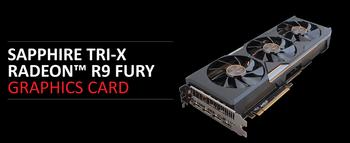Introduction
AMD unveiled the Fiji-powered Radeon R9 Fury X graphics card just under a month ago. Outfitted with a new, space-saving memory technology called HBM and packing in more GCN cores than you could reasonably shake a big stick at, AMD played on the small-yet-powerful theme by watercooling the 7.5in-long card.
The $649 Fury X's graphical punch isn't hard enough to dislodge the rival GeForce GTX 980 Ti or GTX Titan X from the top of our performance charts, particularly at a 4K resolution where it matters most. But at least AMD is back in the high-end graphics game.
Yet stock has been in severe constraint for AMD's best-ever single-GPU graphics card while news of other Fiji-based models - Fury and Fury Nano - has tempted some enthusiasts to hold fire.
Today, AMD and select partners are releasing the Fury graphics card that takes much of the goodness of the X model but reduces price by $100 into the bargain. Enter air-cooled Fiji.
Radeon R9 Fury X |
Radeon R9 Fury |
Radeon R9 390X |
GeForce GTX Titan X |
GeForce GTX 980 Ti |
GeForce GTX 980 |
|
| Launch date | June 2015 |
July 2015 |
June 2015 |
March 2015 |
June 2015 |
September 2014 |
| Codename | Fiji XT |
Fiji Pro |
Grenada XT |
GM200 |
GM200 |
GM204 |
| DX support | 12.0 |
12.0 |
12.0 |
12.1 |
12.1 |
12.1 |
| Process (nm) | 28 |
28 |
28 |
28 |
28 |
28 |
| Transistors (mn) | 8,900 |
8,900 |
6,200 |
8,000 |
8,000 |
5,200 |
| Approx Die Size (mm²) | 596 |
596 |
438 |
601 |
601 |
398 |
| Full implementation of die | Yes |
No |
Yes |
Yes |
No |
Yes |
| Processors | 4,096 |
3,584 |
2,816 |
3,072 |
2,816 |
2,048 |
| Texture Units | 256 |
224 |
176 |
192 |
172 |
128 |
| ROP Units | 64 |
64 |
64 |
96 |
96 |
64 |
| Peak GPU Clock/Boost (MHz) | 1,050 |
1,000 |
1,050 |
1,076 |
1,076 |
1,216 |
| Peak GFLOPS (SP) | 8,602 |
7,168 |
5,914 |
6,611 |
6,060 |
4,981 |
| Peak GFLOPS (DP) | 537 |
448 |
739 |
207 |
189 |
156 |
| Memory Clock (MHz) | 1,000 |
1,000 |
6,000 |
7,012 |
7,012 |
7,012 |
| Memory Bus (bits) | 4,096 |
4,096 |
512 |
384 |
384 |
256 |
| Max bandwidth (GB/s) | 512 |
512 |
384 |
336 |
336 |
224 |
| Default memory size (MB) | 4,096 |
4,096 |
8,192 |
12,288 |
6,144 |
4,096 |
| Memory type | HBM |
HBM |
GDDR5 |
GDDR5 |
GDDR5 |
GDDR5 |
| Power Connectors | 8+8-pin |
8+8-pin |
8+6-pin |
8+6-pin |
8+6-pin |
6+6-pin |
| TDP (watts) | 275 |
275 |
275 |
250 |
250 |
165 |
| GFLOPS per watt | 31.28 |
26.06 |
21.50 |
26.44 |
24.24 |
30.19 |
| Current price (Newegg) | $649 |
$549 |
$429 |
$999 |
$649 |
$499 |
Almost as fast
Radeon R9 Fury uses the same gargantuan silicon as the X model and this means packing 8.9 billion transistors into a die size marginally smaller than 600mm². Shaving performance and thus providing meaningful differentiation between the two Fury cards, AMD drops the number of compute units from 64 to 56. This has the effect of reducing the total number of processors to 3,584 and associated texture units to 224. Everything else, architecturally speaking, remains the same.
The peak boost speed is reduced from 1,050MHz to 1,000MHz, as well, and the combination of 512 fewer shaders and a lower core frequency reduces peak shading and texturing power by approximately 17 per cent, so if a games engine is heavily reliant on those two factors, the Fury X and Pro will be split by a reasonable degree.
The backed, meanwhile, is identical, so lots of bandwidth from 4GB of HBM memory, and we're glad to see that speeds haven't been reduced in the transition to the Pro variant. Carrying on the performance analysis, if a games engine is far more bound by the ROP/memory throughput then Fury X and Pro will benchmark at similar levels. We expect to see Fury-to-Fury performance fluctuate depending upon game title and engine.
Back to air
Fury X's physical appearance is dominated by the all-in-one watercooling unit that promotes the card's small dimensions. Helping keep costs in check and enabling select partners to differentiate their Pro cards from one another - something which is intrinsically difficult on the homogenised X - all cards are equipped with established air-cooling developed by said partner.
News on the grapevine is that Sapphire and Asus will be the first to market with air-cooled Fury cards, and it just so happens that we have a Sapphire Radeon R9 Fury Tri-X OC 4GB (phew!) in for review today.



